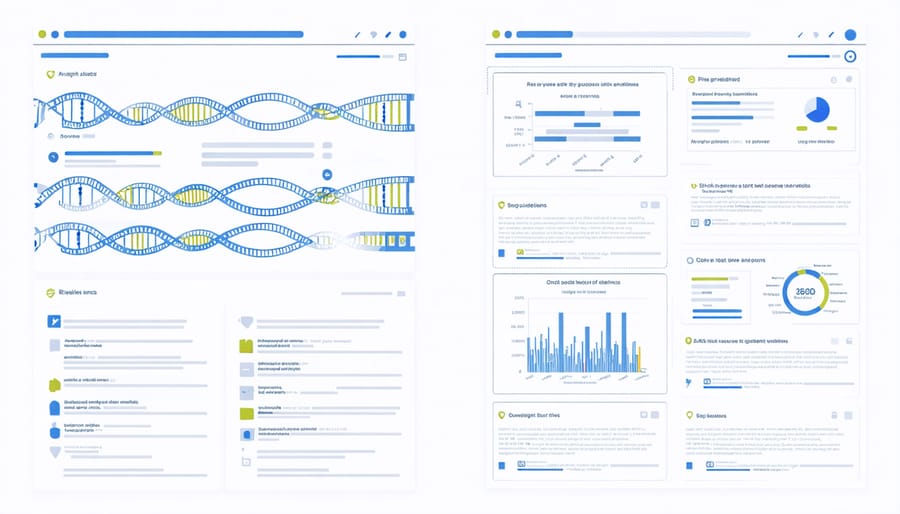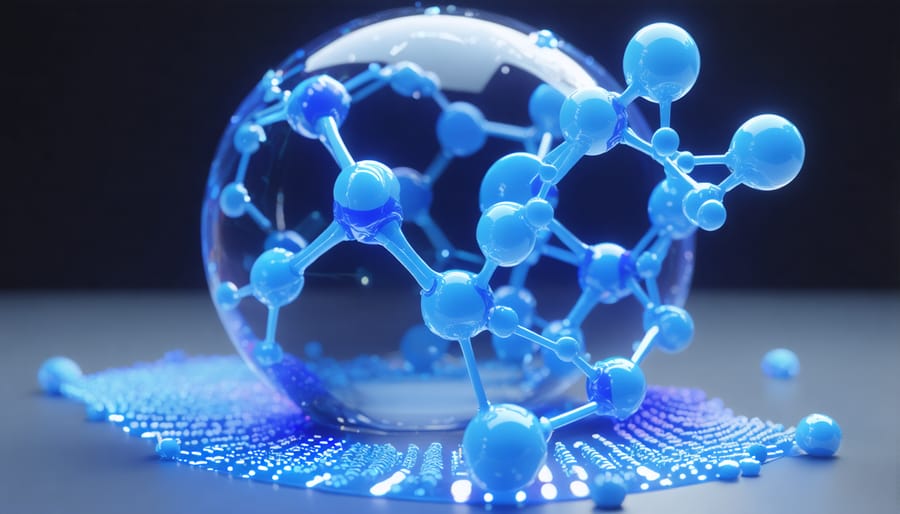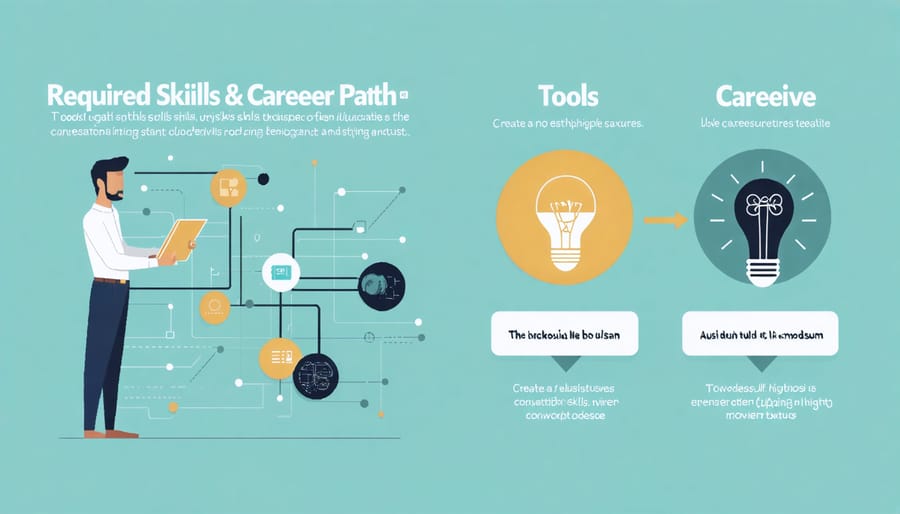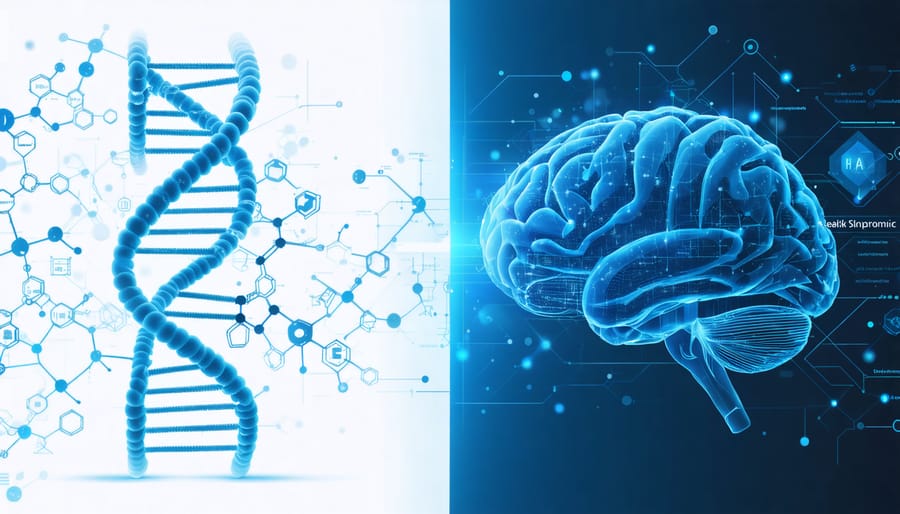In today’s rapidly evolving healthcare technology landscape, bioinformatics and health informatics represent two distinct yet interconnected pathways revolutionizing patient care. While both fields leverage data and AI-driven healthcare solutions, they serve fundamentally different purposes. Bioinformatics focuses on analyzing biological data at the molecular level, decoding genomic sequences, and understanding disease mechanisms through computational methods. Health informatics, conversely, deals with clinical data management, electronic health records, and improving healthcare delivery systems at the patient care level.
As artificial intelligence transforms healthcare delivery, professionals in both disciplines find themselves at the forefront of innovation. Bioinformaticians develop algorithms to predict protein structures and drug interactions, while health informaticists design systems that enhance clinical decision-making and patient outcomes. This convergence of biological science and healthcare technology creates unprecedented opportunities for those seeking to impact medicine through data-driven solutions.
Understanding the distinct roles, required skills, and career trajectories in these fields has become crucial for healthcare technology professionals navigating their career paths in the digital age.
Core Differences Between Bioinformatics and Health Informatics

Bioinformatics: Molecular Focus
Bioinformatics at the molecular level focuses on analyzing and interpreting biological data, particularly DNA, RNA, and protein sequences. Scientists in this field use sophisticated computational tools to understand genetic patterns, predict protein structures, and study molecular interactions that influence disease development and treatment responses.
A key application is genomic sequencing analysis, where bioinformaticians process vast amounts of genetic data to identify mutations, gene variants, and potential therapeutic targets. They develop algorithms that can quickly compare thousands of genetic sequences, helping researchers understand evolutionary relationships and disease markers.
In drug discovery, bioinformatics tools help predict how molecules will interact with specific proteins, streamlining the process of identifying potential new medications. These predictions save countless hours of laboratory testing by narrowing down promising drug candidates before physical experiments begin.
The field also encompasses proteomics, where researchers analyze protein structures and functions using computational methods. This work is crucial for understanding disease mechanisms and developing targeted therapies, making bioinformatics an essential bridge between molecular biology and practical medical applications.
Health Informatics: Patient-Centric Systems
Health informatics focuses on revolutionizing healthcare delivery through patient-centered digital systems. At its core are Electronic Health Records (EHRs), which serve as comprehensive digital repositories of patient information, from medical history to current treatments and test results. These systems enable healthcare providers to access and update patient information in real-time, leading to more informed decision-making and better care coordination.
Modern healthcare delivery systems integrate various technologies to enhance patient care. For instance, patient portals allow individuals to actively participate in their healthcare journey by accessing their medical records, scheduling appointments, and communicating with healthcare providers. Clinical decision support systems help medical professionals by providing evidence-based recommendations and alerting them to potential drug interactions or allergies.
Clinical data management systems ensure the accuracy and security of patient information while facilitating seamless sharing between authorized healthcare providers. These systems implement strict privacy protocols to protect sensitive patient data while enabling efficient workflow management and reducing medical errors. The integration of mobile health applications and wearable devices has further expanded the scope of health informatics, allowing for continuous patient monitoring and preventive care approaches.
AI Applications in Both Fields
AI in Bioinformatics
Artificial Intelligence has revolutionized bioinformatics, transforming how we analyze and interpret biological data. In genetic research, AI algorithms now process vast genomic datasets to identify disease markers and genetic variations with unprecedented accuracy. Machine learning models can predict gene functions and interactions, helping researchers understand complex genetic disorders and develop targeted treatments.
Drug discovery has seen remarkable advancement through AI applications. These systems can screen millions of potential drug compounds in virtual environments, significantly reducing the time and cost of traditional drug development methods. AI algorithms analyze molecular structures and predict drug-protein interactions, enabling researchers to identify promising drug candidates more efficiently than ever before.
AI in molecular modeling has become particularly powerful, allowing scientists to simulate complex protein folding and molecular interactions in three dimensions. This capability helps researchers understand disease mechanisms at the molecular level and design more effective therapeutic interventions.
Deep learning systems are now capable of analyzing protein structures, predicting their functions, and identifying potential binding sites for drug molecules. These innovations have accelerated research in personalized medicine, enabling treatments tailored to individual genetic profiles.
Recent developments include AI-powered systems that can predict antibiotic resistance, design novel proteins, and even forecast the spread of infectious diseases by analyzing genetic mutations. These applications demonstrate how AI continues to expand the boundaries of what’s possible in biological research and medical advancement.

AI in Health Informatics
Artificial Intelligence is transforming health informatics by introducing powerful tools that enhance patient care and streamline healthcare operations. One of the most significant applications is in clinical decision support systems, where AI algorithms analyze patient data to help doctors make more accurate diagnoses and treatment decisions. These systems can process vast amounts of medical literature, patient histories, and diagnostic images in seconds, providing healthcare providers with evidence-based recommendations.
In patient monitoring, AI-powered devices continuously track vital signs and alert medical staff to potential complications before they become critical. Smart sensors and wearable devices collect real-time patient data, while machine learning algorithms detect patterns that might indicate deteriorating health conditions. This proactive approach has significantly improved patient outcomes, especially in intensive care units.
The integration of AI into healthcare administration systems has revolutionized how medical facilities manage their operations. From predictive scheduling that optimizes staff allocation to automated billing processes that reduce errors, AI helps healthcare organizations run more efficiently. Natural language processing helps convert unstructured medical notes into structured data, making it easier to maintain accurate electronic health records.
These AI applications are particularly valuable in resource-limited settings, where they can help bridge gaps in healthcare delivery. For example, AI-powered diagnostic tools can provide preliminary assessments in areas with limited access to specialists, while automated systems can help manage inventory and supply chains more effectively. As AI technology continues to evolve, we can expect even more innovative applications that will further transform health informatics.

Skills and Career Paths
Required Technical Skills
The technical skill requirements for bioinformatics and health informatics reflect their distinct focuses within healthcare technology. Bioinformatics professionals typically need strong programming skills in Python, R, and Perl, which are essential for analyzing biological data and genomic sequences. They must also be proficient in specialized tools like BLAST, GenBank, and various bioinformatics software packages.
In contrast, health informatics professionals focus more on database management systems, electronic health record (EHR) platforms, and healthcare-specific software. While programming knowledge is beneficial, the emphasis is on understanding SQL, data visualization tools like Tableau, and healthcare-specific standards such as HL7 and FHIR.
Both fields require a solid foundation in statistics and data analysis. Bioinformatics practitioners need deeper knowledge of molecular biology and genomics, along with experience in machine learning algorithms for sequence analysis. Health informatics professionals should understand healthcare workflows, medical terminology, and privacy regulations like HIPAA.
Cloud computing skills are increasingly important in both areas, with platforms like AWS and Azure being commonly used. Version control systems (like Git) and collaborative tools are essential for both fields. While bioinformatics tends to be more computationally intensive, health informatics requires stronger system integration and interoperability skills.
For both specialties, professionals should stay current with emerging technologies, particularly in AI and machine learning applications within healthcare.
Career Opportunities and Growth
Both bioinformatics and health informatics offer promising career paths with strong growth potential in today’s digital healthcare landscape. Bioinformatics professionals typically find opportunities in research institutions, pharmaceutical companies, and biotechnology firms, with entry-level salaries ranging from $65,000 to $85,000. Senior bioinformaticians can earn upwards of $120,000, especially in roles involving advanced genomic research and drug discovery.
Health informatics professionals often work in hospitals, healthcare organizations, and consulting firms, with starting salaries between $60,000 and $80,000. Experienced professionals can earn $100,000 or more, particularly in leadership positions such as Chief Medical Information Officer or Health Information Management Director.
The job market for both fields shows robust growth, with the U.S. Bureau of Labor Statistics projecting a 15% increase in health information technology jobs through 2030. Bioinformatics positions are expected to grow at a similar rate, driven by advances in personalized medicine and genetic research.
Emerging opportunities in both fields include artificial intelligence implementation, data analytics, and precision medicine initiatives. Health informatics professionals increasingly focus on electronic health record optimization and telehealth solutions, while bioinformaticians find new opportunities in areas like single-cell genomics and proteomics research. Remote work options are also becoming more common in both fields, offering flexibility and expanded job prospects across geographical locations.
Making Your Choice
Key Considerations
When deciding between bioinformatics and health informatics, several crucial factors deserve careful consideration. First, assess your primary interests: bioinformatics focuses on molecular-level biological data and genetic research, while health informatics deals with patient care and healthcare system optimization.
Consider your educational background and strengths. If you have a strong foundation in biology, genetics, and programming, bioinformatics might be a natural fit. For those with healthcare experience or interest in clinical processes, health informatics could be more appealing.
Career goals play a vital role in this decision. Bioinformatics professionals typically work in research institutions, pharmaceutical companies, or biotech firms, contributing to drug discovery and genomic research. Health informatics specialists often work in hospitals, healthcare organizations, or consulting firms, improving patient care systems and healthcare delivery.
The technology focus also differs. Bioinformatics requires deeper knowledge of computational biology tools and programming languages for genetic analysis. Health informatics emphasizes healthcare-specific software, electronic health records, and data analytics for patient care improvement.
Consider the job market and growth potential in your region. While both fields are growing, health informatics positions may be more abundant due to widespread healthcare digitization. Finally, evaluate the work environment you prefer – laboratory and research settings versus clinical and healthcare environments.
Getting Started
Beginning your journey in either bioinformatics or health informatics starts with understanding the fundamental requirements and pathways available. For bioinformatics, a strong foundation in biology, computer science, and statistics is essential. Start by taking online courses in programming languages like Python or R, which are commonly used in biological data analysis. Platforms like Coursera and edX offer specialized bioinformatics certificates that can help you build core competencies.
For health informatics, focus initially on healthcare systems, data management, and electronic health records (EHR) systems. Many professionals begin with certifications from organizations like HIMSS (Healthcare Information and Management Systems Society) or AHIMA (American Health Information Management Association). These credentials provide valuable industry recognition and practical knowledge.
Both fields require ongoing learning due to rapid technological advancement. Consider joining professional organizations like the International Society for Computational Biology (ISCB) for bioinformatics or AMIA (American Medical Informatics Association) for health informatics. These organizations offer networking opportunities, conferences, and access to latest research and developments.
Practical experience is crucial. Look for internships at research institutions, hospitals, or biotech companies. Create a portfolio of projects demonstrating your skills in data analysis, visualization, and problem-solving. Many universities also offer specialized master’s programs in either field, which can provide comprehensive training and valuable industry connections.
Remember to stay updated with industry trends, particularly in AI and machine learning applications, as these technologies are increasingly integral to both fields.
As we’ve explored throughout this article, bioinformatics and health informatics represent two distinct yet complementary fields in the healthcare technology landscape. While bioinformatics focuses on analyzing biological data and genetic information, health informatics concentrates on managing patient data and improving healthcare delivery systems. Both fields are essential for advancing modern healthcare and offer rewarding career paths for those interested in combining technology with healthcare.
The choice between these fields ultimately depends on your interests and career goals. If you’re fascinated by genetics, molecular biology, and developing computational tools for biological research, bioinformatics might be your calling. On the other hand, if you’re more interested in improving patient care, healthcare systems, and clinical data management, health informatics could be the perfect fit.
Remember that both fields are experiencing rapid growth, particularly with the advancement of AI and machine learning technologies. Whether you choose bioinformatics or health informatics, you’ll be entering a dynamic field with abundant opportunities for innovation and impact on human health.
Consider your strengths, educational background, and long-term career aspirations when making your decision. Both paths offer rewarding careers with competitive salaries and the satisfaction of contributing to healthcare advancement. Whichever path you choose, stay current with technological developments and maintain a commitment to lifelong learning in this ever-evolving field.

